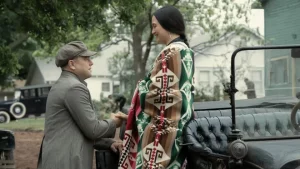Tropic Sprockets / Killers of the Flower Moon
By Ian Brockway
 The auteur Martin Scorsese (Goodfellas) gives us a history lesson with “Killers of the Flower Moon,” zeroing in on a “Reign of Terror” occurring in Oklahoma in 1920. More than 60 wealthy Osage Native Americans were killed either by shootings, poisonings or injections, all due to greed and financial gain. [Showtimes and trailer at TropicCinma.com.]
The auteur Martin Scorsese (Goodfellas) gives us a history lesson with “Killers of the Flower Moon,” zeroing in on a “Reign of Terror” occurring in Oklahoma in 1920. More than 60 wealthy Osage Native Americans were killed either by shootings, poisonings or injections, all due to greed and financial gain. [Showtimes and trailer at TropicCinma.com.]
Right from the start, Scorsese sets things up in a propulsive direction by illustrating the Osage Nation as a happy and well to do community. Indian men and women go to plays and revues. The women shine like stars and men drive flashy cars. The black and white segments of glaring opulence is accompanied by the bouncing electric rock tones of Robbie Robertson of The Band, his final musical soundtrack.
After the rock and roll introduction to Native glamour, we see a glum and wincing Ernest (Leonardo DiCaprio) who just came back from World War I. He goes to see his uncle, Bill Hale (Robert De Niro) who is a reserve sheriff and the unofficial mayor of the town. Bill encourages his nephew to keep an affectionate eye on Mollie (Lily Gladstone) a young Native American woman. Ernest agrees but tells his uncle that he will be on his best behavior.
The next day Ernest is taking Mollie out in his red sports car. Soon they are eating together and kissing.
In between these events we see Ernest taking part in robberies of Osage Native Americans, along with a disturbing roster of the abruptly deceased either by poison or sickness.
A few scenes later, Ernest cannot wait to tell his uncle the good news: Mollie is Ernest’s new love. Uncle Bill is pleased.
Slowly in a series of grim revelations, we know that Uncle Bill is not so loving or benevolent. He pressures men to marry young ladies and then kills both men women or children to gain both insurance money and familial land.
DiCaprio all but disappears here transforming into a sad dullard who is intimidated by his uncle and manipulated to sicken his wife, but he also clearly loves her in a strange and dysfunctional way.
De Niro has a good outing too as the menacing elder of the town. While his role is no stretch, his face wrinkles in all the right forms and figures, and no one quite does danger like De Niro.
It is actor Lily Gladstone, however, who steals the whole show, and she is central to the film. Her very complexion speaks of karma and her impassive stare expresses both silent revenge and a Zen acceptance of inhumanity.
At first it might appear as if “Killers of the Flower Moon” is more reserved and detached than the lurid wild details of “GoodFellas” or “Raging Bull” with its gory pulp and broken noses, but keep in mind, things are not as they seem. In a deliberate and plodding manner that is masterful in rhythm, we see the details in all their smarmy sickening intentions. King Hale is a king gangster, a sociopath, a juggernaut of power. In one scene, Hale laments a newsreel of the Greenwood massacre then he tells Ernest to keep his wife on morphine, slowly weakening her. Hale is an empathetic elder by day and a killer by night. And there are trademark touches of Scorsese gore as well: a blown female head and two meaty dismembered fingers are not for the faint.
This is horror upon horror, all the more necessary today due to the efforts to erase the details of the Osage Murders from Oklahoma schools.
The final scene showcases the Osage Native community twirling and drumming in full paradisiacal splendor. As a karmic kaleidoscope flourishing in color and resilience, the moment makes a just response and a stinging prismatic challenge to the Caucasian conventions of “The Sound of Music” (1965) and “Oklahoma!” (1955).
Write Ian at [email protected]
[livemarket market_name="KONK Life LiveMarket" limit=3 category=“” show_signup=0 show_more=0]





No Comment